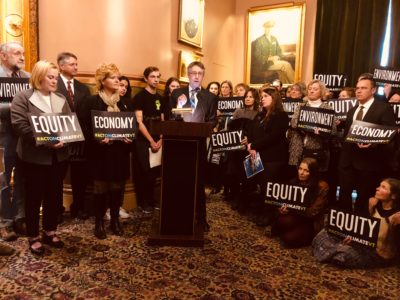The highly-respected and nonpartisan Vermont Legislative Joint Fiscal Office released a strategic road map for actions Vermont policy makers can take to strengthen the local economy, create jobs, lower the cost of living, reduce income inequality, improve public health and limit the pollution causing global warming.
The Decarbonization Study was a primary recommendation of Gov. Phil Scott’s Climate Action Commission in 2017 and was authorized with tri-partisan support by the Vermont House and Senate in 2018. The Joint Fiscal Office commissioned Resources for the Future, a premier academic research firm based in Washington, D.C., to complete the analysis.
The key finding is that there are opportunities to combine carbon pricing with investments in clean energy to achieve Vermont’s commitment to the U.S. Climate Alliance.
Specific findings include:
ECONOMY
- “The combined climate and health benefits of the carbon pricing policies would exceed the economic costs for every carbon pricing scenario considered.”
- “Impacts on the state’s GDP, level of employment, and overall economic welfare would be very small.”
EQUITY
- Climate policy can reduce income inequality. For example, under an ESSEX Plan scenario 60% of Vermont households at the lowest rungs of the economic ladder receive more in rebates than they would pay in costs.
ENVIRONMENT
- “Combining moderate carbon pricing and nonpricing policy approaches [such as incentives for weatherization and electric vehicles] could reduce emissions to meet Vermont’s U.S. Climate Alliance target.”
“Vermont policy makers now have a road map that shows multiple ways to grow the economy and prioritize the most vulnerable Vermonters in a transition to the clean energy future,” said Tom Hughes, Energy Independent Vermont coalition coordinator. “Legislators and the Scott administration should act on these findings this year.”
Additional statements from Vermont business and community leaders:
Joey Bergstein, CEO of Seventh Generation: “There is no greater threat to future generations than the climate crisis and the health of our planet. The analysis is clear that the short term and long term benefits of reducing greenhouse gas pollution far outweigh the costs. We must act now on this opportunity before it’s too late.”
Orielle Koliba, Vermont Youth Lobby organizer and senior at Harwood Union High School: “Gov. Scott and Vermont legislators stood up for young Vermonters last year when they passed gun safety legislation. We’re asking that they do it again and stand up for our future by acting on the climate crisis. The JFO Climate Study gives them a good place to start, it’s their obligation to take its findings seriously and ultimately to act.”
The Rev. Richard Hibbert, President, Vermont Interfaith Power & Light: “There is a moral imperative to address the climate crisis and do so in a way that doesn’t penalize those least responsible for the problem – namely Vermonters with low-incomes who generate less carbon pollution than their wealthier neighbors. I am glad that Gov. Scott and the General Assembly authorized this analysis and hope that they will act on its findings.”
Jen Kimmich, co-founder of the Alchemist Brewery: “Here’s something scary: the biggest threat to our business is climate change. We are already experiencing severe weather changes that effect the main ingredients in our beer- malt, hops and water. Vermont’s senators and legislatures should take that into consideration when they’re reviewing the Joint Fiscal Office’s climate report. A healthy economy depends on the health of our environment”.
Karen Lafayette, Advocate, Vermont Low-Income Advocacy Council: “Vermonters with low-incomes are worried about the climate crisis just like everyone else. In fact, they suffer the most from violent weather events, from the ill effects of carbon pollution, and have the highest energy burdens. This report shows that there are ways of reducing harmful emissions that will address income inequality and can improve the lives of the most vulnerable Vermonters while we transition to a brighter energy future. We hope Vermont policy makers will dig into this study and act on its recommendations.”
David Mears, Executive Director, Audubon Vermont: “Climate change is the biggest threat to Vermont’s birds and the places they need to thrive. Further, climate change does not just impact birds; the negative consequences of burning fossil fuels reach to nearly every aspect of Vermonters’ lives including our economy, environment, and public health. The solutions to reducing carbon pollution are not easy and require leadership. In Vermont, we have an opportunity to demonstrate to an increasingly partisan nation, that our leaders can come together across party lines to adopt new ideas that will work. The report just issued by Resources for the Future to the Vermont General Assembly provides an excellent framework for a conversation that Vermonters need to have about the benefits of carbon pricing.”
Paul Zabriskie, Weatherization Director, Capstone Community Action: “Housing and transportation are two of the biggest challenges facing Vermonters with low-incomes, and they happen to be the biggest contributors to climate pollution as well. This analysis shows that there are ways to reduce pollution while raising up Vermonters with low-incomes. That’s a win-win that the Legislature should act on.”

